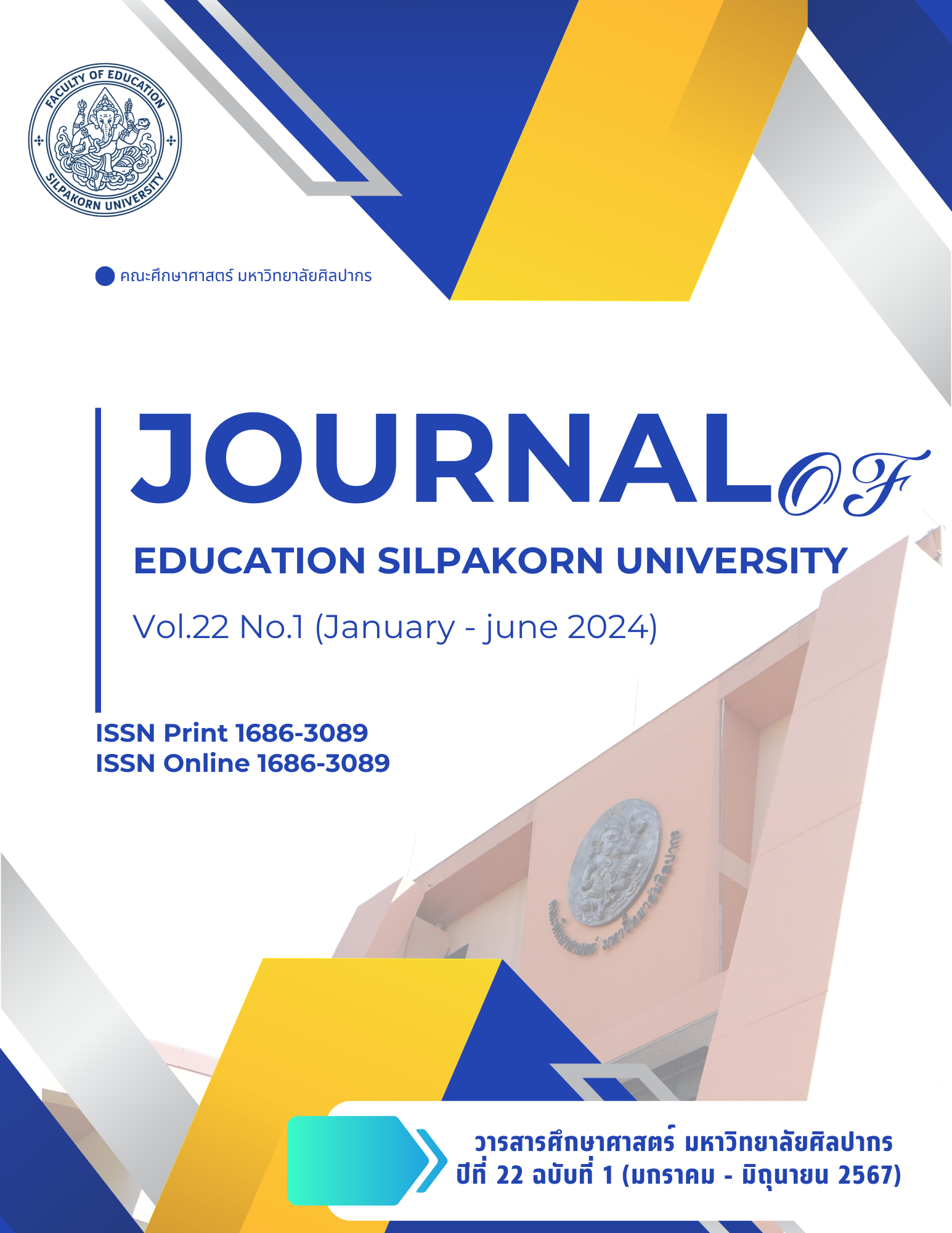Development Learning Model Enhancing Creative Thinking and Creative Innovation Ability for Undergraduate student
Main Article Content
Abstract
This research aimed to 1) develop a science learning model that promotes creative thinking and creative innovation ability for students, and 2) evaluate the effectiveness of the model, including creative thinking and creative innovation ability, and satisfaction of students after using the model. The sample group consisted of 35 first-year undergraduate students studying chemistry in the first semester of the academic year 2023, obtained from simple random sampling. Research tools include creative thinking and creative innovation ability, and satisfaction assessment form. Data were analyzed by finding the mean and standard deviation. The research results found that the science learning management model has 4 components, consisting of 1) principles, 2) expected learning outcomes, 3) 7 learning management steps, including (1) stimulating interest, (2) identifying problems and understanding problems, (3) brainstorm and sequence ideas (4) plan (5) implement the plan (6) present (7) assess and 4) measure and evaluate. After using the model, students' creativity was at a good level ( = 2.99, S.D. = 0.46) and their ability to create innovations was at a good level ( = 2.65, S.D. = 0.38) and students were satisfied with the science learning management at the highest level ( = 4.57, S.D. = 0.55).
Article Details

This work is licensed under a Creative Commons Attribution-NonCommercial-NoDerivatives 4.0 International License.
References
Arends, R.I. (1997). Classroom Instruction and Management. New York: The McGraw-Hill.
Chittep, Namsomboon, Phuangphae and Po Ngern, (2021). The Development of Social Innovation
Creative Ability in Geography Using Design Thinking Process for Mathayom-Five Students.
Journal of Roi Kaensarn Academi, 6(10), 78-93. (In Thai)
Institute for the Promotion of Teaching Science and Technology. (2017). A Manual for the
Curriculum of Fundamentals of Science Course. Bangkok: Ministry of Education. (In Thai)
Inunchot, S., Saewan, M., Kolaka, S., Butsat, P., and Thanthong, S. (2021). The Development of
Instructional Processes by Using Constructionism and Case-Based Learning to Enhance the
Innovative Creation Ability. Academic journal Suan Sunandha Education, 5(1): 74-85.
(In Thai)
Khammanee, T. (2019). Teaching Science for effective learning process management.
Bangkok: Chulalongkorn University Printing House. (In Thai)
Klubsakun, O. and Phonak, D. (2020). A Development of the Steam Education Model to Enhance
Creative Thinking in Digtal Maketing. Academic journal Suvarnabhumi Institute of
Technology, 6(2), 140-151. (In Thai)
Maneewan, S. (2018). Developing a project-based learning model with synergy through Cloud
technology to promote creativity and innovation. The Vocational Journal and technical
studies, 8 (15), 63-76. (In Thai)
Nilsook, P. & Wannapiroon, P. (2013). Imaginary learning (Imagineering). Journal of Technical
Education Development, 25 (86). Retrieved 28 February 2016. Accessed from
https://www.academia.edu (In Thai)
Panich, W. (2012). The way to create learning for pupils in the 21st century. Bangkok: Sodsri
Foundation Sarit Wong. Retrieved 8 February 2014, from http://www.noppawan.sskru.ac.th. (In Thai)
Photsuk,U. (2001). Creative thinkers. Educational management manual for talented persons
Special in high-level thinking skills. Bangkok: Rattanapornchai. (In Thai)
Phornphisutthimas, S. (2013). Learning Management of Science in 21st Century. Journal of Research
Unit on Science, Technology, Environment for Learning, 14(1), 55-63. https://doi.org/10.14456/jstel.2013.7 (In Thai)
Ruechaipanich, W. (2015). Creative-Based Teaching: Creativity-based Learning (CBL). Journal
of Learning Innovations Walailak University, 1(2), 23-37. (In Thai)
Sisamud, K.,Wannapiroon, P. and Palee, P. (2023). Development of the Hybrid Learning Model
with Design Thinking Process to Develop the Creativity. Journal of Humanities and Social
Sciences Thonburi University, 17(1), 108-120. (In Thai)
Sriprapai, P., and Cheausuwantavee, C. (2022). The Learning Management Using Project-Based
Learning to Enhance Students’ Innovative Ability. Journal of MCU Nakhondhat, 9(7), 30-42.
(In Thai)
Songkhram, N. (2014). Innovation Change learners into innovators. Bangkok:Publisher of
Chulalongkorn University. (In Thai).
Taimaung, S.,Thongsorn,P. & Sirisawat,C.(2019). The Development of Science Learning Activity
Package by Applying. The STEM Education Concept to Develop the Creativity and Scientific
Mind for Grade Eight Students. Rajabhat Rambhai Barni Research Journal,14 (2),23-33. (In Thai)
Thanuk, Kittikanampol and Thongsorn, (2020). The Development of Creative Thinking through Project
Based Learning on PopUp Books Creation in Arts Learning Area for Grade 7 Students.
e-Journal of Education Studies, Burapha University. 2(4), 41-52. (In Thai)
The Secretariat of the Council of Education (2017). National Education Plan 2017-2036. Retrieved
April 2017, from https://www.onec.go.th/index.php/page/view/Outstand/2532. (In Thai)
Thongjun, N. and Pankaew, P. (2016). Development of Creative Thinking in Science of Lower
Secondary Student Learning Through Brain Storming. Journal of Graduate Research, 7(1): 1-
(In Thai)
Untinagon, P. and Nillapan, M., (2021). The Development of an Instructional Model by STEM
Education Enhancing Innovation Ability for Primary School Students. Journal of Education
Silpakorn University; 19(1): 206-219. (In Thai)
Weil, M., Joyce, B.R. and Kluwin, B. (1978). Personal Models of Teaching. New Jersey: Prentice-Hall.
Wongyai, W. & Patthaphon, M. (2019). Source of leadership center Curriculum innovation and
Learning. Accessed 8 February 2019, from www.curriculumandlearning.com. (In Thai)


